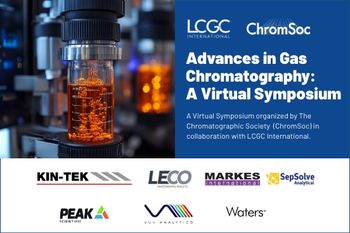
- Hot Topics in Mass Spectrometry
- Volume 41
- Issue s10
- Pages: 14–15
Fast GC–MS for Analyzing Antioxidants & Industrial Food Analysis Applications
LCGC spoke to Hans-Gerd Janssen from the Unilever Foods Innovation Centre in The Netherlands about the advantages of a novel, rapid method to analyze antioxidants that inhibit oxidation.
LCGC spoke to Hans-Gerd Janssen from the Unilever Foods Innovation Centre in The Netherlands about the advantages of a novel, rapid method to analyze antioxidants that inhibit oxidation, and he explains that the maturity of gas chromatography (GC) technology is actually an advantage to the analyst.
Q: You recently developed a fast gas chromatography–mass spectrometry (GC–MS) method for efficacy assessment of natural antioxidants (1). Why is this type of analysis important?
A: As part of Unilever’s commitment to help people transition towards healthier diets, we are reducing the levels of unhealthy saturated fats in our products by replacing them with more healthy unsaturated oils. These unsaturated lipids are more prone to lipid oxidation, resulting in a poor smell and a rapid loss of product quality. To avoid this, antioxidants are needed. Up until now synthetic chemicals were used to this end, but we now try to use “nature’s ingenuity”. Nature has not only provided us with unsaturated fatty acids, but also with natural antioxidants! Many spices and herbs, for example, have antioxidant properties. It is just that you need to find which spices and herbs work, and for that, you need to test them. But because there are many potential natural antioxidant sources, you need to test a lot of them. Hence, the method needs to be fast.
Q: What is novel about the method you developed, and what benefits does it offer the analyst?
A: In literature you will find many methods for testing antioxidant efficacy. Unfortunately, most of these methods are very far from reality. They test radical scavenging activity, metal chelation capacity, or oxygen scavenging. We wanted a test where we are much closer to reality. We wanted to monitor a lipid over its shelf life and monitor the products that are causing the rancid smell of oxidized lipids. Hexanal is one of these species. We have therefore developed an assay where we oxidize lipids under realistic, yet accelerated, conditions and can monitor the effects of antioxidants by following a key product of the oxidation reaction. The main novelty for me is the much more realistic nature of our assay. Moreover, the method is very fast. One measurement takes less than 2 min. The method is also safe for the analyst. There are no toxic chemicals involved. Just sunflower oil, salt, and air.
Q: Were there any particular difficulties you had to overcome when developing the method?
A: There were numerous difficulties. First, there are many potential food ingredients in nature that have an antioxidant capacity. So, we had to narrow the area in which we would search. Spices and herbs were a logical focus area because we wanted to stabilize dry soups and sauces. But even with this focus there were still many possibilities to test and we also knew there could be rather strong synergy effects. We clearly needed a fast method. We also wanted to be realistic, meaning that we wanted to study the actual oxidation reaction, not some type of partial aspect of the complex process of oxidation. So, we needed to accelerate the aging in a realistic way. We studied many routes for acceleration and asked our sensory experts to make sure that the off-smell in the accelerated aging was the same as in real aging. We had already fixed hexanal as the read-out for the assay, but we needed to find a fast method to measure it rapidly at very low levels. GC–MS with selected ion monitoring provided the solution here. A final problem was caused by the heterogeneity of many spices and herbs. We needed to take at least 50 to 200 mg to be representative. But this meant that a rather large volume of oil was needed. In the end our assay was done in 250-mL jars. There were many of them, some up to 200 mL, so we needed a large climate cabinet for aging.
Q: What were your main findings?
A: The main findings we have patented. We found mixtures of three to five common spices or herbs in specific ratios that exert very strong antioxidant effects. From an analytical perspective, I would say the main finding was the high speed and reliability of headspace GC–MS measurements of hexanal. By now we are probably close to 10,000 injections without any major instrumental problems. The rapid hexanal method is now used not only to find new antioxidants, but also to study shelf life stability of our new range of plant-based meat alternatives. We are also thinking of using fast GC–MS on short columns in other applications, such as the dynamic release of flavors from ice cream or the formation of Maillard reaction flavors in cooking.
Q: Are there any specific method development strategies that can turn a “standard” GC method into a “fast GC–MS” method in food analysis?
A: We are very much used to GC runs that take half an hour and basically take that for granted. Admittedly, with fully automated systems this means you can still do some 50 analyses each day. Such a speed you can probably not meet with the sample preparation, data interpretation, and all the paperwork. I think very often the actual GC run is not the rate-determining step. But if you are interested in a shorter run time, the use of a column with a slightly reduced inner diameter is a very simple option. We used a 150 micrometer column. Such a column is roughly twice as fast as the standard 320‑μm column. Reducing the column length is also a simple way to reduce time, at least if you have over-resolution. Finally, GC–MS allows you to separate compounds that are not chromatographically resolved simply by exploiting mass spectral differences. This is also a good method for reducing the analysis time.
Q: GC is often regarded as a mature technology. Are there any technology developments in GC that offer the analyst “new horizons” in food analysis or any areas of GC that you find particularly innovative?
A: GC is absolutely a mature technology. But that should not be interpreted as the technique is dull, no longer important, and not relevant anymore. GC continues to be a very important workhorse in the analytical laboratory. GC being mature also means it is reliable, it has proven its value, and, just as for people, we should think of “lifelong learning and improvement” rather than allow people or techniques to dwindle into oblivion. Field-portable instruments that can be used by less‑experienced users, stable retention times that can be repeated in other laboratories, and elimination of the need for calibration are just a few fields where there is still a lot of work to be done. Recent developments that I think are important include the better software we now have for comparisons of chromatograms, hyphenated systems for complex analyses such as mineral oil saturated hydrocarbons/mineral oil aromatic hydrocarbons (MOSH/MOAH) analysis, and high-resolution mass spectrometry. We should also not forget improvements in the sample preparation area, such as SPME Arrow and thin-film microextraction.
Reference
(1) Janssen, H.-G.; Gah, C.; Steenbergen, H.; Rosing, E.; Spraul, M. A Fast GC–MS-Based Method for Efficacy Assessment of Natural Anti-Oxidants for Inhibiting Lipid Oxidation. J. AOAC Intl. 201, 104 (2), 260–266. DOI:
Hans-Gerd Janssen is Science Leader Chromatography and Mass Spectrometry at the Unilever Foods Innovation Centre, in Wageningen, The Netherlands. He is also a part‑time professor at Wageningen University on the special chair of recognition‑based analytical chemistry. His research interests include the development of chromatographic systems, methods, and theories for food analysis and other applications. He has a PhD in analytical chemistry from Eindhoven University (The Netherlands) and has over 35 years of experience in chromatography research. Direct correspondence to:
Articles in this issue
Newsletter
Join the global community of analytical scientists who trust LCGC for insights on the latest techniques, trends, and expert solutions in chromatography.





